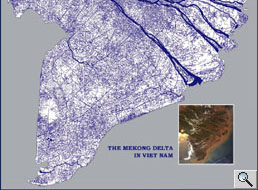The Delta--
Many large rivers discharge to the sea through a delta. The slowing of
current in the coastal flatlands causes massive deposition of silt. The
main channels of the river split and the river reaches the sea through
a number of arms.
 The
various channels are separated by flat floodplains that are often covered
with lakes and marshes. In some deltas the arms end in extensive lagoons
before discharging into the sea. Deltas may be heavily forested, especially
at the seaward end, where dense stands of mangroves are common. Because
deltas are very rich areas, much of the original vegetation has been cleared
for agriculture and, more recently the mangroves have been removed for
shrimp culture.
The
various channels are separated by flat floodplains that are often covered
with lakes and marshes. In some deltas the arms end in extensive lagoons
before discharging into the sea. Deltas may be heavily forested, especially
at the seaward end, where dense stands of mangroves are common. Because
deltas are very rich areas, much of the original vegetation has been cleared
for agriculture and, more recently the mangroves have been removed for
shrimp culture.
Deltas are penetrated by salt water. The degree of penetration depends
on the flooding of the river and the tides. In the flood season they are
mainly freshwater, but in the dry season the lower part of the delta is
salt water and salt water penetrates upstream along the bottom of the
river as a saline tongue often for considerable distances.
This means that the lower part of the river has three zones:
• A permanently freshwater zone inhabited by freshwater species;
• A fluctuating middle zone that is sometimes salty and sometimes fresh. This is inhabited either by freshwater or marine species depending on the time of year. There are also some species that are specialised to living in zones of changing salinity; and
• A permanently saline zone inhabited by marine animals and plants.